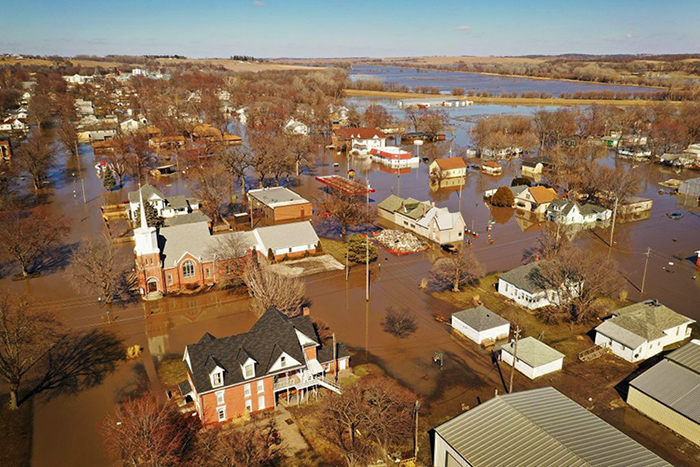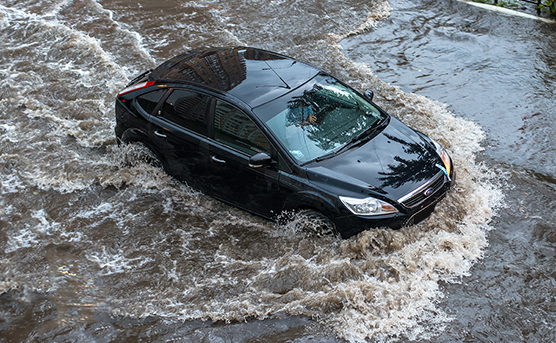Floods
Disasters and Emergencies
Floods and Flash Floods
Floods are one of the most common hazards in the U.S. However, not all floods are alike. Some floods develop slowly – often times over a period of days. But flash floods can develop quickly, sometimes in a matter of minutes and without any visible signs of rain. Flash floods often have a dangerous wall of roaring water that carries rocks, mud and other debris and can sweep away most things in its path.
Overland flooding occurs outside a defined river or stream, such as when a levee is breached, but can still be destructive. Flooding can also occur when a dam breaks, producing effects similar to flash floods – as the Lake Delhi Dam in Delaware County, Iowa, did in July 2010.
You should be aware of flood hazards no matter where you live, but especially if you live in a low-lying area, near water or downstream from a dam. Even very small streams, gullies, creeks, culverts, dry streambeds, or low-lying ground that appear harmless in dry weather can flood. Every state is at risk for flooding.
Mitigation pays. It includes any activities that prevent an emergency, reduce the chance of an emergency happening, or lessen the damaging effects of unavoidable emergencies. Investing in mitigation steps now such as constructing levees and purchasing flood insurance will help reduce the amount of structural damage to your home and financial loss from building and crop damage should a flood or flash flood occur.

Know what to do before, during, and after a flood.
Iowa disaster history
The Great Flood of 1993
The Great Flood of 1993 is considered by many to be one of the most defining natural disasters in Iowa history. Flooding resulted in 17 fatalities and around $2.7 billion in damage (nearly $4.5 billion in 2013 inflation-adjusted dollars). Over 10,000 people were evacuated from their homes and 21,000 homes were damaged–many destroyed. During the summer of 1993 some locations saw rain each day for 130 consecutive days. Some areas flooded more than 5 times. Agricultural yields dropped by 62 percent. Each of Iowa’s 99 counties was declared a Federal Disaster Area. When President Clinton surveyed the Des Moines area flooding on July 14th he stated, “I have never seen anything on this scale before.”
Video credit: KCCI 8 Des Moines
Fatalities
People Evacuated
Homes Damaged/Destroyed
$ Billion in Damage
READY IOWA has resources that you can share on social media to promote flood preparedness in your home and community.

Turn Around, Don't Drown!
BEFORE, DURING, & AFTER A FLOOD
BEFORE A FLOOD
- Find out if you live in a flood-prone area from your local emergency management office or Red Cross chapter.
- Ask whether property is above or below the flood stage water level and learn about the history of flooding for your region.
- Learn flood warning signs and your community alert signals.
- Request information on preparing for floods and flash floods.
- If you live in a frequently flooded area, stockpile emergency building materials. These include plywood, plastic sheeting, lumber nails, hammer and saw, pry bar, shovels, and sandbags.
- Have check valves installed in building sewer traps to prevent flood waters from backing up in sewer drains. As a last resort, use large corks or stoppers to plug showers, tubs, or basins.
- Plan and practice an evacuation route. Contact the local emergency management office or local Red Cross chapter for a copy of the community flood evacuation plan. This plan should include information on the safest routes to shelters. Individuals living in flash flood areas should have several alternative routes.
- Have disaster supplies on hand.
- Develop a family emergency communication plan.
- Learn about the National Flood Insurance Program (NFIP). Ask your insurance agent about flood insurance. Most homeowners policies do not cover flood damage.
- Catalog your belongings. Take photos of rooms, furniture, books, appliances, computer equipment, DVDs, and other items of value. Keep your catalog or “inventory list” in a safe place.
DURING A FLOOD WATCH
- Pay attention to the news, and know the latest storm information.
- Fill bathtubs, sinks and jugs with clean water in case water becomes contaminated.
- Bring outdoor belongings, such as patio furniture, indoors.
- Move valuable household possessions to the upper floors or to safe ground if time permits.
- If you are instructed to do so by the local authorities, turn off all utilities at the main switch and close the main gas valve.
- Be prepared to evacuate.
DURING A FLOOD
If Indoors
- Turn on battery-operated radio or television to get the latest emergency information.
- Get your pre-assembled emergency supplies.
- If told to leave, do so immediately.
If Outdoors
- Climb to high ground and stay there.
- Avoid walking through any floodwaters. If it is moving swiftly, even water six inches deep can sweep you off your feet.
If In A Car
- If you come to a flooded area, turn around and go another way.
- If your car stalls, abandon it immediately and climb to higher ground. Many deaths have resulted from attempts to move stalled vehicles.
During an Evacuation
- If advised to evacuate, do so immediately.
- Evacuation is much simpler and safer before flood waters become too deep for ordinary vehicles to drive through.
- Listen to a battery-operated radio for evacuation instructions.
- Follow recommended evacuation routes; shortcuts may be blocked.
- Leave early enough to avoid being trapped by flooded roads.
AFTER THE FLOOD
Assessing the Situation
- Flood dangers do not end when the water begins to recede. Listen to a radio or television and don’t return home until authorities indicate it is safe to do so.
- Remember to help your neighbors who may require special assistance: infants, elderly people, and people with disabilities.
- Inspect foundations for cracks or other damage.
- Stay out of buildings if flood waters remain around the building.
- When entering buildings, use extreme caution.
- Wear sturdy shoes and use battery-powered lanterns or flashlights when examining buildings.
- Examine walls, floors, doors, and windows to make sure that the building is not in danger of collapsing.
- Watch out for animals, especially poisonous snakes, that may have come into your home with the flood waters. Use a stick to poke through debris.
- Watch for loose plaster and ceilings that could fall.
- Take pictures of the damage–both to the house and its contents for insurance claims.
- Look for fire hazards.
- Broken or leaking gas lines
- Flooded electrical circuits
- Submerged furnaces or electrical appliances
- Flammable or explosive materials coming from upstream
- Throw away food – including canned goods – that has come in contact with flood waters.
- Pump out flooded basements gradually (about one-third of the water per day) to avoid structural damage.
- Service damaged septic tanks, cesspools, pits, and leaching systems as soon as possible. Damaged sewage systems are health hazards.
Inspecting Utilities in a Damaged Home
- Check for gas leaks. If you smell gas or hear a blowing or hissing noise, open a window and quickly leave the building. Turn off the gas at the outside main valve if you can and call the gas company from a neighbor’s home. If you turn off the gas for any reason, it must be turned back on by a professional.
- Look for electrical system damage. If you see sparks or broken or frayed wires, or if you smell hot insulation, turn off the electricity at the main fuse box or circuit breaker. If you have to step in water to get to the fuse box or circuit breaker, call an electrician for advice.
- Check for sewage and water line damage. If you suspect sewage lines are damaged avoid using the toilets and call a plumber. If water pipes are damaged, contact the water company and avoid the water from the tap. You can obtain safe water by melting ice cubes.